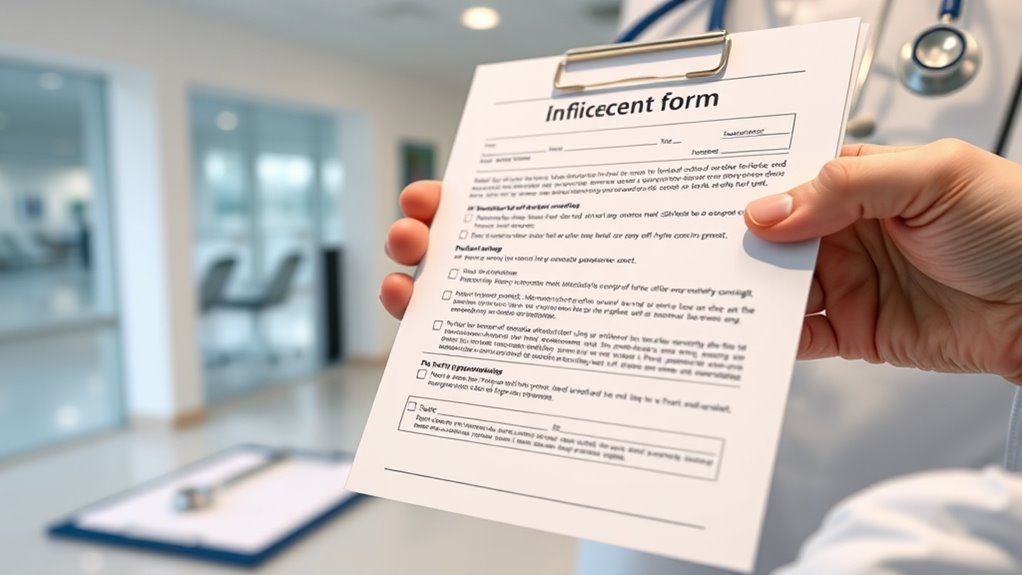Understanding medical consent forms means knowing they give healthcare providers permission to perform treatments or procedures after explaining the risks, benefits, and alternatives. They protect your rights and ensure you make an informed choice. Consent forms include details like your identity, the procedure, risks, and signatures. By comprehending these key elements, you can confidently decide and communicate your preferences. To learn more about what to check and ask before signing, keep exploring these important topics.
Key Takeaways
- Medical consent forms inform patients about procedures, risks, and alternatives, ensuring voluntary and informed decision-making.
- Different forms serve specific purposes, such as general informed consent, emergency authorization, or procedure-specific approvals.
- Key elements include patient identification, detailed procedure descriptions, potential risks, and signatures to validate understanding.
- Informed consent upholds ethical standards, promotes patient autonomy, and legally protects both patients and healthcare providers.
- Reviewing consent forms carefully, clarifying doubts, and considering cultural factors ensure genuine understanding and valid agreement.
What Are Medical Consent Forms and Why Are They Important

Medical consent forms are vital documents that explain a patient’s treatment options and secure their permission before procedures are carried out. They ensure you understand what’s involved, including potential risks and benefits. These forms are grounded in medical ethics, emphasizing respect for your autonomy and right to make informed decisions about your health. Legally, they fulfill requirements to protect both you and healthcare providers, establishing clear consent and reducing liability. Without proper consent, medical practitioners could face legal repercussions. These forms serve as a fundamental record that you have agreed knowingly and voluntarily to the proposed treatment. By signing the form, you confirm you’ve received sufficient information and have had the chance to ask questions, making sure your rights and safety are prioritized throughout your medical care. Recognizing informed consent as a core principle helps ensure that your participation in medical procedures is both ethical and legally protected.
Types of Medical Consent Forms

There are different types of medical consent forms you should be aware of, each serving a specific purpose. Informed consent forms provide detailed information about procedures, while emergency consent forms allow quick decisions when time is critical. You’ll also encounter specific procedure authorizations that focus on particular treatments or interventions. Understanding key financial terms can help you better navigate the legal and financial implications involved in medical consent processes.
Informed Consent Details
Have you ever wondered what types of consent forms you might encounter before a medical procedure? These forms vary based on the procedure and legal requirements. Here are four common types:
- General Consent Forms
- Informed Consent for Surgery
- Informed Consent for Imaging or Tests
- Consent for Experimental Treatments
Informed consent is rooted in medical ethics and respects your patient autonomy. It guarantees you understand the risks, benefits, and alternatives before agreeing. Different forms offer varying levels of detail, but all aim to empower you to make informed decisions. Knowing which form you’re signing helps you grasp your rights and the scope of your consent, fostering trust between you and your healthcare provider. Recognizing these distinctions helps ensure your autonomy is upheld throughout your medical journey. Additionally, understanding the types of medical consent forms can help you better navigate your healthcare options and advocate for yourself effectively.
Emergency Consent Variations
In emergency situations, obtaining a full informed consent can be challenging when immediate action is necessary to save your life or prevent serious harm. To address this, emergency consent variations often allow healthcare providers to proceed without a signed form, especially when cultural considerations or language barriers exist. If you’re unable to give consent, providers may rely on implied consent, assuming you’d agree to treatment to save your life. They may also use emergency waivers or verbal consent, documented afterward. It’s vital that providers recognize cultural differences and language barriers that could impact understanding. Recognizing these emergency consent variations ensures that urgent care isn’t delayed while respecting your rights, even when full consent isn’t feasible at the moment.
Specific Procedure Authorizations
Specific procedure authorizations are essential forms that grant healthcare providers permission to perform particular medical interventions. These forms specify the procedure, risks, and alternatives, ensuring you understand what’s involved. With digital consent growing, privacy concerns become more relevant, making secure methods crucial. When completing these forms, consider:
- The clarity of the procedure description
- How your privacy concerns are addressed
- Whether digital consent options are secure and user-friendly
- Your right to revoke consent at any time
Using digital consent streamlines the process but requires trust in the platform’s security. Always verify that your information remains confidential and that your privacy concerns are acknowledged. AI in Business can help improve the efficiency and accuracy of consent management systems, enhancing overall patient experience. Specific procedure authorizations help protect your rights while enabling necessary medical care efficiently.
Key Elements Included in Consent Documents

When reviewing a consent form, you’ll notice it includes your identification details to verify accuracy. It also describes the procedure clearly, so you understand what’s involved, along with potential risks and alternatives. These key elements help you make an informed decision about your healthcare. Additionally, understanding the history of medical procedures can provide context for informed consent practices.
Patient Identification Details
Patient identification details are essential components of consent forms because they guarantee the document is accurately linked to the correct individual. Proper identification helps prevent mix-ups and ensures the right person receives appropriate care. When reviewing consent forms, make sure these details are clear and correct to avoid privacy concerns or misunderstandings, especially if language barriers exist. Ensuring privacy policies are followed during the process also helps protect patient information. Key elements include: 1. Full name and date of birth 2. Medical record or patient ID number 3. Contact information 4. Signature and date Providing accurate details reduces the risk of errors, respects patient privacy, and ensures legal validity. Confirming these details early helps streamline communication and minimizes confusion, especially in diverse or multilingual settings.
Description of Procedure
Accurately describing the procedure in consent forms helps guarantee patients understand what to expect and agree to. Use clear, straightforward language and include relevant medical terminology to clarify the steps involved. Be specific about the type of procedure, the techniques used, and the expected outcome, so patients can make informed decisions. Remember, precise descriptions also address legal considerations, demonstrating that the healthcare provider has explained the process thoroughly. Avoid vague or ambiguous language that could lead to misunderstandings or legal disputes. Providing a detailed yet understandable explanation ensures the patient knows what will happen, reducing confusion and enhancing trust. Clear documentation of the procedure protects both you and the patient by establishing a shared understanding of the medical intervention. Incorporating detailed on-device AI capabilities can further aid in explaining complex procedures through visual aids or interactive content.
Risks and Alternatives
Including a clear explanation of risks and alternatives is essential in consent forms because it helps you understand potential complications and options available. Knowing your alternatives, like alternative treatments, allows you to make informed decisions. It’s also important to contemplate cultural considerations, which may influence your choices and comfort levels. Here are four key points to look for:
- The specific risks associated with the procedure or treatment.
- Alternative treatments available and their benefits.
- Possible outcomes if you choose not to proceed.
- How cultural considerations may impact risks and alternatives.
Additionally, understanding building codes and zoning regulations relevant to your treatment environment can impact your options and safety measures.
Understanding these elements ensures you’re fully aware of what to expect and can discuss concerns with your healthcare provider confidently.
The Role of Informed Consent in Healthcare

Informed consent serves as a cornerstone of ethical healthcare, ensuring that you understand and agree to your medical treatments. It promotes medication safety by making sure you’re aware of potential risks and benefits before proceeding. This process also safeguards your patient confidentiality, respecting your right to control personal health information. When you give informed consent, you actively participate in decisions about your care, which helps build trust with your healthcare providers. It’s not just a form; it’s an essential part of ethical practice that empowers you to make well-informed choices. By understanding what’s involved, you can better weigh the options and feel confident about your healthcare journey. Recognizing the importance of trust issues in relationships, informed consent ultimately helps protect your rights and promotes safe, respectful treatment.
When and Why You Might Need to Sign a Consent Form

You will need to sign a consent form whenever a healthcare provider recommends a procedure or treatment that involves risks or significant changes to your health. This guarantees clear doctor-patient communication and helps protect both you and your provider legally. Here are key situations when signing is necessary:
- When undergoing surgery or invasive procedures
- Before starting new medications with potential side effects
- For diagnostic tests that carry risks, like biopsies
- When considering treatments with significant legal implications
Signing confirms you understand the risks and agree to proceed. It’s crucial to ask questions if anything is unclear, as your signature also has legal significance. Always review the form carefully to guarantee informed participation in your healthcare decisions.
Understanding Risks and Alternatives in Consent Forms

When signing a consent form, it’s important to understand not just the procedure itself but also the risks involved and the available alternatives. Cultural considerations can influence how risks are communicated and understood, so ask if explanations align with your background. Language barriers might prevent you from fully grasping the details, so request information in your preferred language or a translator if needed. Knowing the potential risks helps you weigh the benefits against possible complications. Alternatives could include less invasive options or different treatments, so don’t hesitate to ask about these choices. Being fully informed ensures you’re making a decision that respects your cultural perspective and language needs, leading to a more confident and informed consent process.
How to Read and Review a Medical Consent Form Carefully

Reading a medical consent form carefully is essential to guarantee you fully understand what you’re agreeing to before signing. Pay close attention to the details, especially regarding legal terminology and cultural sensitivities, to avoid confusion later. Here are four key steps to review effectively:
Carefully review medical consent forms to understand legal terms and cultural considerations before signing.
- Clarify Legal Terminology – Ensure you understand all technical terms or ask for explanations.
- Check for Cultural Sensitivities – Confirm the form respects your cultural beliefs and practices.
- Read the Entire Document – Don’t skip sections; every part is important for your understanding.
- Ask Questions – If anything is unclear, seek clarification before signing.
Being meticulous helps safeguard your rights and ensures informed consent.
Your Rights and Responsibilities When Signing Consent Forms

After carefully reviewing a medical consent form, it’s important to understand your rights and responsibilities before signing. Your rights as a patient include maintaining patient autonomy, meaning you have the right to make informed decisions about your care. You can ask questions, seek clarification, and refuse treatment if you choose. At the same time, you have legal responsibilities to provide honest information about your health, understand the risks involved, and give voluntary consent. Signing the form confirms that you understand the procedure and agree to it, but it doesn’t mean you waive your rights. Be sure you fully understand what you’re agreeing to, and never feel pressured into signing. Your active participation helps protect both your rights and your health.
Frequently Asked Questions
Can I Refuse Treatment After Signing a Consent Form?
You can refuse treatment even after signing a consent form, as your rights as a patient include the ability to change your mind at any time. However, be aware of the legal implications, such as potential impacts on your care or liability issues for providers. It is crucial to communicate clearly with your healthcare team, understand your rights, and document your decision to guarantee your wishes are respected and legal considerations are addressed.
Are Consent Forms Legally Binding Documents?
You might find it surprising, but consent forms are indeed legally binding documents. They carry significant legal implications, ensuring that healthcare providers have your informed approval before treatment. As a patient, your rights include the ability to refuse or withdraw consent at any time, even after signing. Always remember, signing a consent form doesn’t mean you lose control; it confirms you understand the treatment and agree voluntarily.
How Do I Withdraw Consent Once Given?
You can withdraw consent at any time to respect your patient autonomy, even if you’ve previously agreed to a procedure. Simply inform your healthcare provider clearly and promptly. In emergencies, exceptions may apply, and medical teams might proceed without consent to save your life. Always communicate your wishes as soon as possible to ensure your rights are upheld, and understand that withdrawal might not be possible in all urgent situations.
Do Minors Need to Sign Consent Forms?
Think of minors signing consent forms like a young tree needing a guardian’s support. Usually, minors under a certain age face strict age restrictions, meaning they can’t give legal consent on their own. Parental authority typically allows a parent or guardian to sign for them, ensuring proper medical care. However, laws vary by location, so it’s important to check local regulations to understand when minors can consent independently.
What Happens if I Don’T Understand the Form Fully?
If you don’t fully understand the form, you risk agreeing to something you’re uncomfortable with or don’t comprehend. Language barriers or cultural differences can make it harder to grasp what you’re signing, so don’t hesitate to ask questions or request a translator. Healthcare providers should make certain you understand before proceeding. Always speak up if you’re unsure, so you can make informed decisions about your care.
Conclusion
Think of medical consent forms as your health’s trusted map, guiding you through the journey with clarity and confidence. By understanding each turn and detail, you’re the captain steering your well-being. Remember, these forms are your shield and key, opening informed choices and safeguarding your rights. So, approach them with curiosity and care, knowing you hold the steering wheel to navigate your healthcare voyage safely and confidently.









